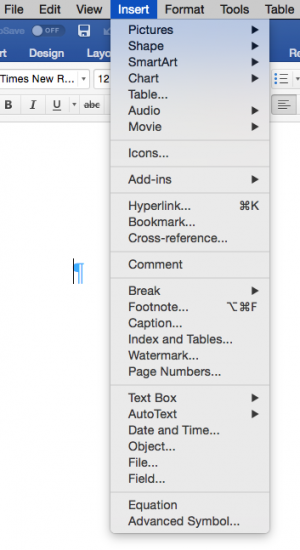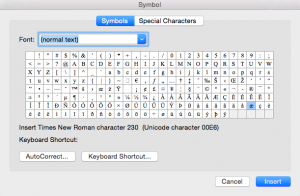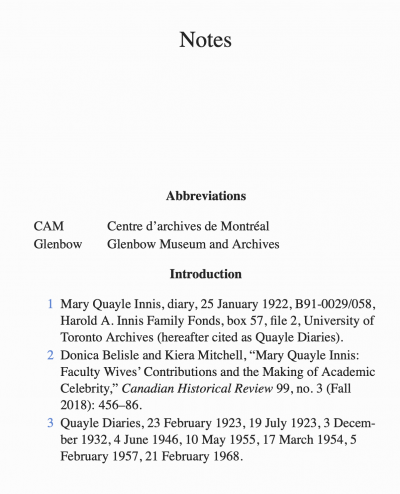Table of Contents
Symbols & Abbreviations/Acronyms
Symbols
Symbols will need to be replaced using Advanced Symbol in Word. Simply go to the top menu bar in word, select the dropdown menu for Insert and select Advanced Symbol.

This will open up a new window.

Then you just have to select the appropriate symbol and click Insert.
Using Unicode for Symbols
For any symbols that aren’t in Word, you will need to insert the symbol using Unicode. First, you will need to set up your keyboard for Unicode input.
List of Control Characters for Unicode
Graphemica - Find the unicode for all characters
Once your keyboard is set up you can insert the symbol.
For a Mac press and hold the Option key as you enter the appropriate code. For Windows it is the same process but with the Alt key.
Abbreviations & Acronyms
We keep abbreviations as they appear in the text.
Q&A Archive
Q: In the book A Girl Named Lovely, there is the following sentence: "Of that, C$128 million was matched by the government, adding up to C$282 million." I know text-to-speech software can handle the $ just fine but when I run it through Word's built in TTS, it doesn't interpret it as "Canadian Dollars" as intended. Is it okay if I change the sentence to "Of that, 128 million Canadian Dollars was matched…"?
A: In this case leave it as it is, most advanced screen readers will be able to read it.
Q: Stay the Blazes Home makes frequent reference to COVID-19 with COVID being capitalized. I realize this is an acronym and so we would usually leave it capitalized, but I'm wondering if I can change it to lower case letters due to the frequency used (I don't want it to be jarring to the reader to have the letters read out each time) and because people often pronounce it "covid" in everyday speech? Thanks for your help!
A: You can leave it as COVID.
Q: I am working on a book that uses internet language. For instance there are hastags (#) and there are @ symbols to indicate atSarah, i.e. @Sarah. How should we format these?
A: For hashtag and @ text strings, or any text that is strung together it is important to put them in Pascal Case. In this way, most screen readers will read it properly and it’s also easier for sighted readers to read the text when it’s like that. For example: #accessiblereadingforthewin can be edited to #AccessibleReadingForTheWin
As for the hashtag symbol itself, nothing special needs to be done—you can simply use the # (number sign) key on your keyboard. Any symbols that exist on your keyboard or in MS Word itself can be inserted as usual.
Q: In Joy of Cooking, the authors make use of 3 symbols to indicate optional steps or tips/tricks. The triangle and arrows appear as images in the Word doc. How should I handle these?
Example in context:
A: Use Unicode to enter them in as symbols. Here are the wiki directions for how to treat symbols.
Q: How should I format 'æ'? The book I have uses a lot of older medical terms (e.g. Bullæ , Squamæ,Papulæ , æther, etc.)
A: You can insert these letters using Insert > Advanced Symbol in Word. It may appear as all caps after insertion, but you can change that to lowercase using the appropriate button in the toolbar.
Q: If we have Ampersands in the text, or simlar symbols such as # or %, should we replace them with the proper word?
If the symbols are actually part of the original text then we keep them. If it’s a result of a messed up conversion, we can fix them. Text-to-speech is smart!
Q: Should abbreviations like "A.M." and "A.D." retain their periods, or be changed to "AM" and "AD"? I am just wondering if the periods would make it sound awkward as a DAISY talking book.
A: We can keep abbreviations as they are written. TTS will read "A.M." and "A.D." as intended. Also, one thing to keep in mind is that many people with print impairments read the e-text, so it's best to keep it as true to the original writing as possible.
Q: Another TTS question: will things like "I had a 16' dinghy" and "there were 5.5" medium guns" be said as feet and inches?
A: It would depend on the text-to-speech software being used. VoiceOver (Mac's built-in TTS) recognizes these as measurements and reads them as such, i.e. "five feet five inches" and "16 foot dinghy". If you're using Mac and are curious how text is read, you can enable TTS (same if you're using Windows, which uses Narrator). Q: How should I handle mentions of World War II? Do I leave the "II" as is, change it to 2, or something else?
A: You can leave it as is. Most TTS software is able to read it properly.
Q: I'm almost positive that I know the answer to this one (TTS is smart!) but just wanted to double check: Should ordinal numbers (1st, 2nd, etc.) be written out all in normal text? Or should the abbreviated letters be superscript, as Word prompts them to be when typed out?
A: How things are read aloud depends on the TTS software being used, but yes - generally TTS is smart :) I tested it on my Mac (which uses VoiceOver) and it reads "1st" and 1st with the st as superscript the same way – as "first". I've yet to come across a case where numbers are misread.
Q: I'm working on Purchasing Power and the notes section has a brief preface with common abbreviations. I've added the notes according to the workflow and I'm wondering what to do with the remaining abbreviation information. Can I add a heading for "Abbreviations"? Thanks for your help!

A: Good question. Adding a heading for Abbreviations is a good way to go!
Q: It Was Never Going to Be Okay features a poem featuring a bunch of emojis. What do I do with these? Is this an alt-text question?
A: These are treated like symbols. You can use unicode for emojis. The direction is on the Symbols, Abbreviations & Acronyms Page.
Q: Another question for "Until We Are Free," in the article "7 Organizing Direct Action in the Digital Age" there is a star symbol next to the first occurrence of the term "direct action" and an asterisk in-front of the heading of the next sub-section title 'what is direct action?'. It seems the star is being used to inform readers that this term will be explained later in the text and not as an endnote. As it does not seem that the star is not being used as an endnote reference should it be removed or should the star be replaced using the unicode symbol?
A: You can include an asterisk for both using your keyboard: * No need to use unicode for that symbol
Q: I'm working on Mina Parmi Les Ombres, a French book. The book mentions a century using roman numerals and a superscript "e" (which I'm presuming would be like "th" in English). I'm not sure how I should format this so the screen reader reads it properly. I don't see anything in the advanced symbols/special characters window. Do I need to install a French keyboard option?
A: Superscripts are not part of the symbols. You can use the direct formatting buttons on the home ribbon, and there are some short keys. Here is a link to more instructions.
Q: General question for a number of upcoming non-fiction books: Should we keep "COVID" all-caps? While it's a medical word, given that it is not pronounced letter-by-letter in general society, I'm wondering if it would be frustrating for listeners to hear it spelled out one letter at a time.
A: Really good question. There are variations on how screenreaders will read the Acronym, and also people will be reading this book with a braille display. Since some screen readers will read it as a full word, and braille readers will need to proper acronym we should keep it in all caps.





